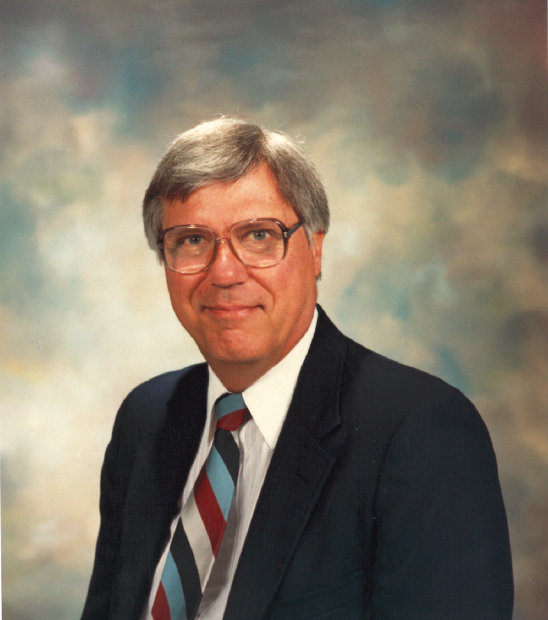FRANK J. SCHUH
1935–2020
Elected in 1989
“For innovation and leadership in the advancement of drilling procedures and design methods, particularly the technology for high-angle drilling.”
BY KEITH K. MILLHEIM
FRANK JOSEPH SCHUH was all about the profession of drilling. A pioneering innovator and industry leader in drilling technology, especially horizontal drilling, he worked for ARCO Oil and Gas Company as head of drilling and production mechanics research and later was the founder and president of Drilling Technology Inc. He passed away in Plano, Texas, December 24, 2020, at age 85.
He was born February 3, 1935, in Columbus, Ohio, to Sebastian and Elizabeth Schuh. When the time came, he attended the Ohio State University, where he earned concurrent BS and MS degrees in petroleum engineering in 1956.
In 1956 as a drilling engineer at ARCO he developed the tools and techniques for medium curvature horizontal drilling, and the company was one of the first to drill such wells as a research effort.
As soon as Frank retired from ARCO in 1984, he founded his own company, mainly to promote the use of horizontal drilling. He developed novel geological targeting techniques and methods for calculating the stresses in horizontal drilling.
In many conversations about how the drilling engineering profession was not acknowledged in comparison to reservoir, production, and facility engineering, he was adamant that one of his goals was to change that. And he did. With his
technological innovations and outspoken commitment, Frank’s lasting impact on the oil industry was profound.
He was one of the very first champions of drilling engineering, and it can be said that he significantly helped the United States develop oil and gas reserves using horizontal drilling technology, which was previously thought to be uneconomical. He not only helped develop the technology but also was a key player in selling it to industry. His leadership and gregarious nature made people listen. Today’s reliance on horizontal drilling is a tribute to his vision and persistence.
As a champion for drilling engineering, Frank pushed the discipline through his active engagement in organizations like the Society of Petroleum Engineers (SPE). He was chair of the Dallas SPE Section (1979), a Distinguished SPE Lecturer (1982), served on the SPE Board of Directors (1982–84), and chaired SPE forums on Well Control, Well Design Methods, and Horizontal Drilling. For his indefatigable efforts, he received the SPE Drilling Engineering Award in 1986 and was designated a distinguished member.
Even with his extensive involvement in the SPE he was frustrated with its lack of attention to the drilling engineering profession. So in 1981 he founded (and chaired) the Drilling Engineering Association, which built a significant membership. In addition, he was active with the International Association Drilling Corporation (IADC; in 1987 he chaired the SPE/IADC Program Committee) and American Petroleum Institute, for which he chaired the Standardization Committee for Valves and Wellhead Equipment (1985–88).
Parallel to his activities with professional societies and associations, Frank taught workshops on horizontal drilling, was active with the University of Tulsa, authored numerous technical articles, and had 29 patents in a broad range of drilling areas.
For the National Academies, he volunteered his expertise as a member of the Committee to Examine the Research Needs of the Advanced Extraction and Process Technology Program (1992–93). And after his election to the National Academy of Engineering in 1989, he made the most of his membership by
serving on the Earth Resources Engineering Peer Committee (1995–97; vice chair, 1997–98; chair, 1998–99), Section 11 (Earth Resources Engineering) Executive Committee (1998–99), Committee on Membership (Peer Committee chair, 1998–99; vice chair, 1999–2000; chair, 2000–01), 2000 Nominating Committee (1999–2000), and Membership Policy Committee (2005–08).
In addition to his NAE election, his contributions were recognized with his selection to receive the AIME’s 1994 Robert Earll McConnell Award and the Ohio State University’s 1995 Benjamin G. Lamme Meritorious Achievement Medal.
There is no doubt that he also influenced many people on his journey through life. I was one of them. In 1989 Frank was the first drilling-oriented engineer inducted into the NAE. The next year I was elected and later learned it was Frank who had sponsored my nomination.
When Frank and I got together, after exhausting oil-related topics, we would discuss areas of mutual interest—football and in particular the Dallas Cowboys. He was an adamant fan of the Cowboys and would discuss the details and strategies of the team, acquired from his attendance at special Cowboys events with the coaches. But we did have one area of debate: who was better, his Ohio State Buckeyes or the University of Oklahoma Sooners.
Frank was a family man who loved his summer vacations sailing and coaching baseball with his children. He was also a diehard golfer—given a chance he’d be on a golf course. He was a member of St. Rita Catholic Community in Dallas since 1965 and taught CCD (the Confraternity of Christian Doctrine, or catechism).
Frank is survived by Alice Kasler, his wife of 64 years, their sons Dwain J. Schuh (Kimberly) and Michael J. Schuh (Wyn), six grandchildren, and two great-grandchildren. He was preceded in death by daughter Barbara Ann Van Zile (Thomas).
I will always remember Frank with his constant smile, his humor, his readiness to discuss and debate, and his passion for drilling technology and drilling engineering.





